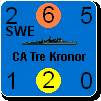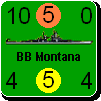Neilster
Posts: 2890
Joined: 10/27/2003
From: Hobart, Tasmania, Australia
Status: offline

|
quote:
ORIGINAL: composer99
On the new map scale it should be easier for Japan to attack the USSR along the Trans-Siberian rail from Vladivostok to Chita now that the HQs can move hexes without automatically flipping.
Getting further than that should still prove to be difficult.
From a tactical consideration, how would the Japanese, say, try to capture Irkutsk? It seems to me that getting this city is absolutely key if the Japanese are going to be at all effective in an anti-Russian campaign; for otherwise they have no hope of getting further.
My own impression is that the Japanese would be best off resorting to a paradrop into or near the city and catching up later with overland forces. Risky and perilous for the expensive units involved.
The other thing is that a major land commitment outside of China and Japan's regular overseas defence perimeter seems like a dangerous case of overstretch.
Plus you can almost certainly forget about seizing somewhere like India or Australia.
Here's what the WiF scenario booklet has to say (with the caveat that things are different at the new scale)...
This second wave is your primary strategic decision to make. Your options are: India, Australia and New Zealand, or Honolulu. All are difficult campaigns, and it is highly unlikely that you will be successful if you try to switch from one to the other in mid stream. It is not even likely that you will succeed at the campaign you choose! For this reason, conservative Japanese players might follow a fourth option based purely on perimeter defense.
The attack on India is both the most difficult and potentially the most rewarding. This campaign should only be undertaken with solemn promises from your European allies that they are making the control of the Suez Canal a top priority. If it is, your campaign will be complementary. The Japanese navy can easily cut overseas supply through the Red and Arabian Seas to help the Axis take Egypt, and the pressure on the Commonwealth in the Med will divert reinforcements to that theater, and probably prevent the Allies from slipping reinforcements into India via the Mediterranean. While getting ashore in India is easy, getting to Delhi is difficult. Simply put, Japan will have to make a very large commitment of land troops to push inland, and at the same time will need to maintain an iron blanket blockade around India to prevent outside help, all while keeping the Americans busy in the eastern Pacific!
Your first goals in this strategy must be to take Ceylon, get ashore in India, probably south and west of Calcutta, and possibly even to push some units overland from Siam through Burma, to press Calcutta from both sides. With your naval superiority, you should be able to take Calcutta and Ceylon. After that, though, it is up to the IJA to attack inland, and this will be very difficult. If you try to conquer India, you must make a maximum commitment to doing so, paring all other theaters, especially China, down to the bare minimum ground troops. If you succeed, and the Axis conquer Egypt, you will link up in the Middle East and divide the rich oil fields between you!
An attack on Australia is like India in many ways. It is easy to get ashore, and grabbing Brisbane should be feasible. By the time you are able to press southwards however, the Americans will be getting very pesky on your flanks, and quite possibly they will be able to maintain sea communications to south eastern Australia. More importantly, they will be able to threaten your vital sea lines in the South China and China Seas.
One possibility for Japan is to invade and conquer New Zealand first. This will give the Aussies more time to prepare, but it may do a better job of securing your blockade in the region. Either of these courses for the Australasia campaign will stretch your navy to its fullest, because your supply lines will be long, your fleet will be needed for offensive operations against your target, and your main opponent, the US navy, will be free to attack you.
If you are able to take Honolulu, you will be able to interrupt overseas communications between the United States and the rest of the Pacific Ocean, which can have numerous benefits.
The best approach to Honolulu is to invade some of the hexes to its west, probably including Midway. This will give you vital air bases to project power into the Hawaiian Islands and Christmas Island sea zones. The only way you can take Honolulu itself is to cut off its supply, and you must dominate all three sea zones to do this ~ no easy task. However, a dedicated attempt to do so is sure to draw American forces into battle on terms presumably of your choosing. Make the most of the battle and don’t let a Midway-like disaster happen to you!
The fourth option is one of strategic defense. This calls for setting up a strong defensive perimeter and husbanding your fleet and air forces. Your perimeter must include all of the islands in and adjacent to the South China Sea, the Bismarck Sea, and the Marianas. It should also include as many other ports adjacent to the Marshalls, the Solomons, the Coral Sea, the Timor Sea, and the Bay of Bengal as possible.
This second layer of sea zones brings you into conflict, as they are defended, and many (i.e., Honolulu, India, Australia) are not really part of this strategy at all. However, some minor ports which are strategically located should be secured; nab as many of Midway, Suva, Espiritu Santo, Guadalcanal, Port Moresby, Portuguese East Timor, Colombo and Trincomalee as you can. Additionally, an overland seizure of Burma will grab you another oil resource and provide excellent defensive terrain to forestall Allied overland attacks out of India.
If this strategy sounds familiar, it is because it is pretty much what the Japanese historically pursued (by default or design). Their original war plans were almost exactly these. Don’t commit the same mistakes they did by dividing your forces and trying to pursue too many of the secondary campaigns at once! Keep your forces focused, especially since you are not directly hunting the American fleet, which might counterattack at any moment.
Cheers, Neilster
|
 Printable Version
Printable Version






 Mr. Bywater agreed with you Patrice
Mr. Bywater agreed with you Patrice 



 New Messages
New Messages No New Messages
No New Messages Hot Topic w/ New Messages
Hot Topic w/ New Messages Hot Topic w/o New Messages
Hot Topic w/o New Messages Locked w/ New Messages
Locked w/ New Messages Locked w/o New Messages
Locked w/o New Messages Post New Thread
Post New Thread